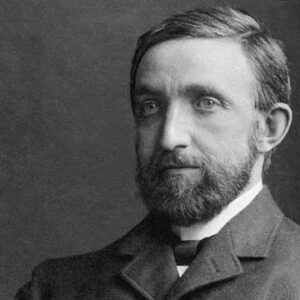Philipp Eduard Anton von Lenard was a well-known physicist from Germany. For his work on cathode rays, he received the Nobel Prize in Physics. He used the fact that cathode rays may flow through thin metal leaves to create a cathode-ray tube with an aluminum window that allowed the rays to escape into the open air. Phosphorescence and luminosity have always piqued Lenard’s interest. He built on Heirich Hertz’s work on the photoelectric effect, demonstrating that when ultraviolet light strikes metal electrons, an electric field can increase or decrease their speed, or a magnetic field can block their routes. Sir Albert Einstein’s hypothesis of quanta of photons, which was based on Lenard’s work, was the first to prove this theory. Einstein never forgave Lenard for associating his name with the discovery. Philipp Lenard also invented the first type of the ‘three-electrode light,’ which was utilized in radioelectric devices. He won numerous honorary doctorates and awards, but he believed he was being overlooked, which explains his attacks on other physicists. He was also a member of Hitler’s National Socialist Party and a prominent figure in the Nazi-era’Deutsche Physik’ movement.
Childhood and Adolescence
Philipp Lenard was born on June 7, 1862, in Bratislava, Pressburg, Hungary. Philipp von Lenardis, his father, was a wealthy winemaker and wholesaler in Pressburg. Antonie Baumann, Lenard’s mother, died while he was a child, and he was raised by his aunt. She married his father in the end.
He began his education at ‘A Pozsonyi királyi katholikus fögymnasium,’ where his teacher, Virgil Klatt, left an indelible impression on him.
His father finally agreed to let him continue his education at the Technische Hochsculen in Vienna and Budapest after much wrangling. He went there to study physics and chemistry in 1880.
He travelled to Heidelberg, Germany, in 1883, to study physics for four semesters under Robert Bunsen, who had long been a “hidden object of worship” to him. In 1883–1884, he matriculated at Heidelberg University.
He began working on his PhD thesis in Berlin in the summer of 1885 and finished it in Heidelberg in 1887.
Career of Philipp Lenard
In 1889, he made a key discovery when he discovered that phosphorescence is induced by the presence of very minute amounts of copper, bismuth, or manganese.
He worked as an assistant at Heidelberg for three years before moving to England to work in the “City and guides of the London Central Institution’s” electromagnetic and engineering laboratories.
He arrived in Bonn on April 1, 1891, to work under the eminent physicist Heirich Hertz. Lenard oversaw the publication of Hertz’s three-volume work, ‘Gesammelte Werke,’ after his death in 1894.
Despite the fact that he was primarily involved in cathode ray experiments, he qualified as a lecturer in 1892 with a work on hydroelectricity.
He succeeded in building a tube with a ‘Lenard window’ in 1892, which directed Cathode rays into open air or a second evacuated room.
He received his first offer of an associate professorship in Breslau in October 1894, but he accepted a nontenured lectureship at the Technische Hochschule in Aachen after a year.
In October 1896, Lenard began working at Heidelberg as an assistant professor.
He became a professor and director of the physics laboratory at Kiel in 1898.
In 1907, he was named professor and director of the University of Heidelberg’s physics and radiology laboratory.
In August 1914, swept up in a rush of patriotism and nationalism, he wrote ‘England und Deutschland zur Zeit des Großen Krieges,’ in which he claimed that German researchers’ work was routinely hidden and copied by British academics.
He compared ‘dogmatic Jewish physics’ with pragmatic ‘German physics,’ and published four volumes under the title ‘Deutsche Physik’ between 1936 and 1937.
On May 15, 1926, Lenard, one of the earliest supporters of National Socialism, went to a party meeting in Heilbronn to see Adolf Hitler in person. He quickly rose to become one of Hitler’s most trusted scientists.
Philipp Lenard, a professor of theoretical physics at Heidelberg University, retired in 1931.
After Hitler’s death in 1945, the Allied occupation forces ousted him from his position.
Major Projects of Philipp Lenard
By adding a thin aluminum window to the glass tube, Philipp Lenard was able to investigate cathode radiation outside of the glass tube. This interpretation was further supported by Albert Einstein’s light quanta hypothesis.
Achievements & Awards
The Royal Society gave him the Rumford Medal in 1896, and the Italian Society of Sciences gave him the Matteucci Medal in 1897.
Philipp Lenard won the Nobel Prize in Physics in 1905 for his work in the field of atomic physics on cathode rays.
He was awarded the Franklin Medal by the Franklin Institute in Philadelphia, Pennsylvania, in 1932.
During his time as a professor at Heidelberg University, he was made an emeritus professor.
Personal History and Legacy
Phillip Lenard died on May 20, 1947, in Messelhausen, Germany, at the age of 84.
Estimated Net Worth
The estimated net worth of Philipp Lenard is unknown.
Trivia
The book ‘The Man Who Stalked Einstein: How Nazi Scientist Philipp Lenard Changed the Course of History’ by Bruce J. Hillman, Birgit Ertl-Wagner, and Bernd C. Wagner is about Lenard’s life and the conflict between his work and that of Albert Einstein.


